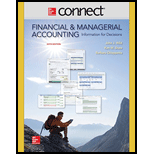
Concept explainers
Inventory: Inventory refers to the stock or goods which will be sold in the near future and thus is an asset for the company. It comprises of the raw materials which are yet to be processed, the stock which is still going through the process of production and it also includes completed products that are ready for sale. Thus inventory is the biggest and the important source of income and profit for the business.
Periodic inventory system: In periodic inventory system the changes in the stock items are reported periodically unlike recording as and when purchases or sales take place.
Cost of goods sold: Cost of goods sold is the total expenses or the cost incurred by the business during the process of manufacturing of goods and is directly related to the production. It generally includes the cost of raw material, labor and other
Gross profit: The profit earned by the company after charging or debiting the cost and the expenses during the production of the goods and to make them ready for sale from the sales made in a fiscal year is the gross profit.
First in first out: In case of First in, first out method, also known as FIFO method, the inventory which was bought first will also be the first one to be taken out.
Last in first out: In case of Last in, First out, also known as LIFO method, the inventory which was bought in the last will be taken out first.
The cost of the ending inventory and the cost of goods sold using:
(a) FIFO
(b) LIFO
(c) Gross margin for FIFO and LIFO method.
Given info,
The cost of goods available for sale is $18,750
(a)
First in, first out method (FIFO)
Cost of ending inventory
| Particulars | Amount($) |
| Most recent cost; October 26: | |
| 100 units @ $25 per unit | 2,500 |
| Next most recent cost; July 30: | |
| 120 units @ $20 per unit | 2,400 |
| Total cost of the ending inventory | 4,900 |
Cost of goods sold
Formula to calculate cost of goods sold is,

Substitute $18,750 for cost of goods available for sale (given) and $4,900 for cost of ending inventory (as calculated above) in the above formula.

Want to see the full answer?
Check out a sample textbook solution
Chapter 5 Solutions
Connect 2 Semester Access Card for Financial and Managerial Accounting
- Can you help me solve this general accounting question using the correct accounting procedures?arrow_forwardCan you help me solve this general accounting question using valid accounting techniques?arrow_forwardHello tutor please given General accounting question answer do fast and properly explain all answerarrow_forward
- I need guidance in solving this financial accounting problem using standard procedures.arrow_forwardI am trying to find the accurate solution to this general accounting problem with appropriate explanations.arrow_forwardPlease provide the solution to this general accounting question with accurate financial calculations.arrow_forward
- I need guidance with this general accounting problem using the right accounting principles.arrow_forwardHow can I solve this financial accounting problem using the appropriate financial process?arrow_forwardTransactions: Dec. 3 Wrote off Langston Corporation’s past-due account as uncollectible, $645.75. M203. 9 Accepted a 90-day, 8% note from Farris Company for an extension of time on its account, $2,400.00. NR23. 18 Received cash from Storage Solutions for the maturity value of NR19, a 90-day, 9% note for $2,000.00. R455. 21 Coastal Supply dishonored NR21, a 90-day, 8% note, for $3,000.00. M245. 30 Received cash in full payment of Langston Corporation’s account, previously written off as uncollectible, $645.75. M232 and R463. Task 1 Journalize the transactions for Miller Corporation in Questions Assets that were completed during December of the current year. Use page 12 of the general journal and page 12 of the cash receipts journal. Task 2 Post each entry to the general ledger and to the customer accounts in the accounts receivable ledger. You will not need to make entries to the Item columns of the ledgers. Task 3 Continue to…arrow_forward
- E-M:11-18 Using payback to make capital investment decisions Consider the following three projects. All three have an initial investment of $600,000. Net Cash Inflows Year Project L Project M Project N Annual Accumulated Annual Accumulated Annual Accumulated 1 $ 150,000 $ 150,000 $ 100,000 $ 100,000 $ 300,000 $300,000 2 150,000 300,000 200,000 300,000 300,000 600,000 3 150,000 450,000 300,000 600,000 4 150,000 600,000 400,000 1,000,000 5 150,000 750,000 500,000 1,500,000 6 150,000 900,000 7 150,000 1,050,000 8 150,000 1,200,000 1. Determine the payback period of each project. Rank the projects from most desirable to least desirable based on payback. 2. Are there other factors that should be considered in addition to the payback period?arrow_forwardKindly help me with this General accounting questions not use chart gpt please fast given solutionarrow_forwardPlease help me solve this general accounting problem with the correct financial process.arrow_forward

 AccountingAccountingISBN:9781337272094Author:WARREN, Carl S., Reeve, James M., Duchac, Jonathan E.Publisher:Cengage Learning,
AccountingAccountingISBN:9781337272094Author:WARREN, Carl S., Reeve, James M., Duchac, Jonathan E.Publisher:Cengage Learning, Accounting Information SystemsAccountingISBN:9781337619202Author:Hall, James A.Publisher:Cengage Learning,
Accounting Information SystemsAccountingISBN:9781337619202Author:Hall, James A.Publisher:Cengage Learning, Horngren's Cost Accounting: A Managerial Emphasis...AccountingISBN:9780134475585Author:Srikant M. Datar, Madhav V. RajanPublisher:PEARSON
Horngren's Cost Accounting: A Managerial Emphasis...AccountingISBN:9780134475585Author:Srikant M. Datar, Madhav V. RajanPublisher:PEARSON Intermediate AccountingAccountingISBN:9781259722660Author:J. David Spiceland, Mark W. Nelson, Wayne M ThomasPublisher:McGraw-Hill Education
Intermediate AccountingAccountingISBN:9781259722660Author:J. David Spiceland, Mark W. Nelson, Wayne M ThomasPublisher:McGraw-Hill Education Financial and Managerial AccountingAccountingISBN:9781259726705Author:John J Wild, Ken W. Shaw, Barbara Chiappetta Fundamental Accounting PrinciplesPublisher:McGraw-Hill Education
Financial and Managerial AccountingAccountingISBN:9781259726705Author:John J Wild, Ken W. Shaw, Barbara Chiappetta Fundamental Accounting PrinciplesPublisher:McGraw-Hill Education





